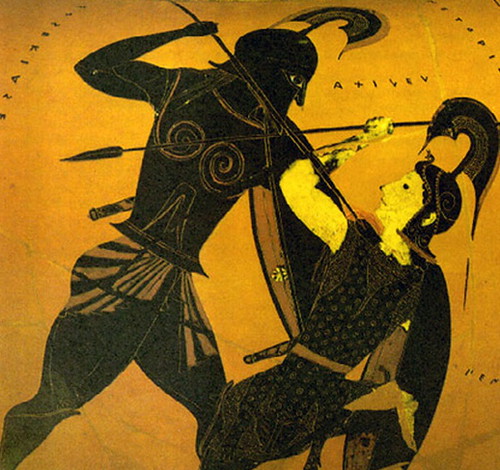Manhood Is Not Brutality
Rage—Goddess, sing the rage of Peleus’ son Achilles,
murderous, doomed, that cost the Achaeans countless losses,
hurling down to the House of the Death so many sturdy souls,
great fighters’ souls, but made their bodies carrion,
feasts for the dogs and birds,
and the will of Zeus was moving toward its end.
Begin, Muse, when the two first broke and clashed,
Agamemnon lord of men and brilliant Achilles.
—The Iliad
Western civilization has always had two competing sacred texts: The Iliad and the Bible. We have long pretended we can form a nice synthesis of the two—that Homer’s Achilles and Isaiah’s Immanuel are somehow compatible ideals, but they are not. The rage of Achilles and the peace of Immanuel are fundamentally contradictory visions for the ideal of humanity in general and of manhood in particular. Those who derive their ideal of manhood from the pagan vision personified in Achilles will never be able to reconcile it with the ideal of manhood depicted in Christ. Achilles or Christ? Who is our model of manhood? We must choose. We must choose between the brutal way of Achilles and the peaceable way of Christ. And if you feel compelled to appeal to the whip-wielding Christ in the temple as an attempt to synthesize the two, let me simply say that Christ cleansing the temple is a world away from the violence of The Iliad that dominates imaginations from Homer to Hollywood; i.e. Jesus’ prophetic protest against religious exploitation is no endorsement of a “Walker, Texas Ranger” version of Messiah!
(I have much to say about this, but I will reserve those thoughts for more serious writing.)
Last Wednesday—the last day of our annual summer vacation in the mountains—I spent the whole day perched on the side of a mountain reading the Bible, Annie Dillard, and John Howard Yoder. I read most of Yoder’s The Original Revolution that day. What follows is a (slightly edited) portion from the chapter entitled “Christ, the Hope of the World.” (This chapter is taken from a lecture Yoder gave in 1966…yet it sounds as if it were written yesterday.)
Ladies and Gentlemen, John Howard Yoder…
Manhood Is Not Brutality
Not only the history books preach a view of man according to which physical and political violence is the ultimate test of the value and of personal merit. It is also the case for popular poetry and literature, all the way from the classical tales of the age of chivalry to the modern morality legends of the Western film, the spy story, and the cover story of the successful businessman in Time magazine. What these stories impress deeply upon the soul is not simply the picture of a personage but a view of the universe. They tell us we are in a universe where there are “bad guys” who are utterly beyond redemption. The only satisfactory result of the conflict with them must be that they be banished or crushed. The “bad guy” is not evil because we know that he has wittingly done evil deeds or expressed malevolent intentions; he is bad by definition, by status, because he belongs to the wrong side.
Then there are the good guys. Goodness, like evil, is not morally based. The good guys lie and kill just like the others; but they are on the right side, they are good because of the cause they represent. This guarantees not only that they have the right to lie and to kill but also that they will always win out in the end.
We have here a picture of the whole moral universe; one which (at least in the United States) has manifestly influenced the national personality and the national style in international affairs, as we can observe in the history of the past few years most abundantly:
a. All conflicts are reducible to black and white moral issues, where one party is wholly wrong, so wrong as to forfeit his right to exist, and the other party right, so right as to be authorized to do almost anything for his cause.
b. Moral issues are not determined from a personal moral perspective but on the basis of “sides.”
c. For those who are on the wrong side, even their good deeds are deceptive facade; for those who are on the right side, even the most evil deeds are excusable.
d. The good guy is sure to be successful in deceit and in physical combat; the story always comes out that way.
The legend paints for youth, those who are most ready to learn, a picture of the nature of the moral universe which is fundamentally false. It is not true, from either the biblical or the historical perspective, that the world is divided into two organizations, two societies, one good and one evil. It is not the case, either factually or on a more careful logical or biblical analysis, that the good man is generally triumphant in physical or intellectual conflict. It is not true, from the perspectives of either logic or of the Bible, that every possible means can be considered justifiable if it is used toward an end considered desirable.
At this point, modern critical thinking and faith in Jesus Christ will coincide. They join in condemnation of the self justifying vision of conflict and manhood being traced by these legends. If we once dare to challenge the picture, and see it crumble, we then can discover that in fact violence and deceit represent a particular form of moral weakness (the same parallel relationship of violence and deceit which we observe was striking in the Sermon on the Mount).
Secrecy and deceit are forms of slavery. The United States experience of the past few years has demonstrated publicly several times that government secret intelligence agencies have been a major source of misinformation. [!] Likewise physical or psychic violence is a confusion of moral weakness. He who resorts to blows confesses he has no better arguments. And yet our legend literature, making virtue, personal courage, and success in combat coincide as they do not in real life, sustains a pagan, pre-Christian confusion of manhood with brutality.
Thus spake Yoder.
BZ
(The art is a Grecian urn depicting Achilles slaying Hector.)
P.S. Just for fun, here’s a picture from my day of reading on the mountain side.

